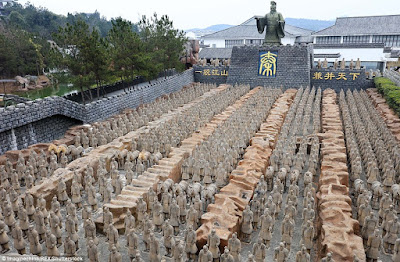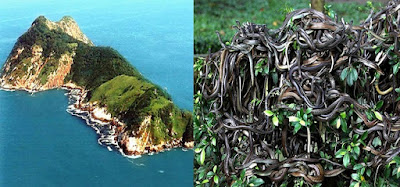Qin Shi Huang Di's Tomb (Statue of Thousand soliders )
Workers digging a well outside the city of Xi'an, China,
in 1974 struck upon one of the greatest archaeological discoveries in the world: a
life-size clay soldier poised for battle.
The diggers notified Chinese authorities, who dispatched
government archaeologists to the site.
They found not one, but thousands of clay soldiers, each
with unique facial expressions and positioned according to rank. And though
largely gray today, patches of paint hint at once brightly colored clothes.
Further excavations have revealed swords, arrow tips, and other weapons, many
in pristine condition.
The soldiers are in trench like, underground corridors. In
some of the corridors, clay horses are aligned four abreast; behind them are
wooden chariots.
The terra-cotta army, as it is known, is part of an
elaborate mausoleum created to accompany the first emperor of China into the
afterlife, according to archaeologists.
YOUNG EMPEROR
Ying Zheng took the throne in 246 B.C. at the age of 13.
By 221 B.C. he had unified a collection of warring kingdoms and took the name
of Qin Shi Huang Di—the First Emperor of Qin.
During his rule, Qin standardized coins, weights, and
measures; interlinked the states with canals and roads; and is credited for
building the first version of the Great Wall.
According to writings of court historian Siam Qian during
the following Han dynasty, Qin ordered the mausoleum's construction shortly
after taking the throne. More than 700,000 laborers worked on the project,
which was halted in 209 B.C. amid uprisings a year after Qin's death.
To date, four pits have been partially excavated. Three
are filled with the terra-cotta soldiers, horse-drawn chariots, and weapons.
The fourth pit is empty, a testament to the original unfinished construction.
Archaeologists estimate the pits may contain as many as
8,000 figures, but the total may never be known.
TOMB
Qin's tomb itself remains unexcavated, though Siam Qian's
writings suggest even greater treasures.
"The tomb was filled with models of palaces,
pavilions and offices as well as fine vessels, precious stones and
rarities," reads a translation of the text.
The account indicates the tomb contains replicas of the
area's rivers and streams made with mercury flowing to the sea through hills
and mountains of bronze. Precious stones such as pearls are said to represent
the sun, moon, and other stars.
Modern tests on the tomb mound have revealed unusually
high concentrations of mercury, lending credence to at least some of the
historical account.
Chinese archaeologists are also using remote-sensing
technology to probe the tomb mound. The technique recently revealed an underground
chamber with four stair like walls. An archaeologist working on the site told
the Chinese press that the chamber may have been built for the soul of the
emperor.
Experimental pits dug around the tomb have revealed
dancers, musicians, and acrobats full of life and caught in mid-performance, a
sharp contrast to the military poses of the famous terra-cotta soldiers.
But further excavations of the tomb itself are on hold, at
least for now.
"It is best to keep the ancient tomb untouched,
because of the complex conditions inside," Duan Qinbao, a researcher with
the Shaanxi Provincial Archaeology Institute, told the China Daily.





Comments
Post a Comment
Your suggestions